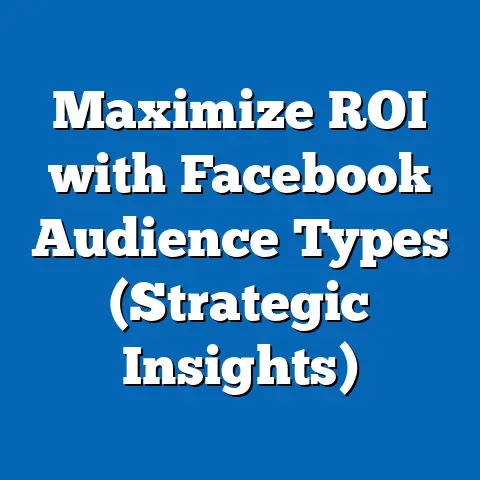Navigating Political Ads on Facebook (Essential Guidelines)
1. Understanding Political Ads on Facebook
Political advertising on Facebook is a unique beast. It’s not just about promoting a product or service; it’s about influencing public opinion, mobilizing voters, and shaping the narrative around critical issues. To effectively navigate this complex landscape, it’s crucial to understand what constitutes a political ad, the role Facebook plays in modern political campaigns, and the various types of political ads you can run.
What Constitutes a Political Ad on Facebook?
Facebook defines political ads broadly. According to their policies, a political ad is any advertisement that:
- Refers to a clearly identified candidate, political party, elected official, or legislation. This includes ads that explicitly endorse or oppose a candidate, party, or piece of legislation.
- Addresses national legislative issues of public importance. This covers a wide range of topics, from healthcare and education to climate change and immigration.
- Is placed by or on behalf of a political organization or campaign. This includes ads run by official campaign committees, political action committees (PACs), and other groups involved in political advocacy.
It’s important to note that Facebook’s definition is intentionally broad to capture a wide range of content that could influence political outcomes. Even seemingly innocuous ads that mention a candidate or address a political issue can be classified as political ads.
The Role of Facebook in Modern Political Campaigns
Facebook has become an indispensable tool for modern political campaigns. Its vast reach, sophisticated targeting capabilities, and relatively low cost make it an attractive platform for reaching voters and influencing public opinion. Here’s why Facebook is so important in the political arena:
- Reach: With billions of active users worldwide, Facebook offers unparalleled reach to political campaigns. It allows them to connect with voters in every demographic and geographic location.
- Targeting: Facebook’s granular targeting options allow campaigns to reach specific groups of voters based on their interests, demographics, behaviors, and even political affiliations. This enables them to deliver highly personalized messages to the most receptive audiences.
- Engagement: Facebook is a highly engaging platform where users spend a significant amount of time consuming content, interacting with friends and family, and participating in discussions. This makes it an ideal environment for political campaigns to engage with voters and build support.
- Affordability: Compared to traditional advertising channels like television and print, Facebook advertising is relatively affordable. This makes it accessible to campaigns of all sizes, from grassroots movements to national parties.
Types of Political Ads on Facebook
Political ads on Facebook come in many forms, each designed to achieve different objectives. Here are some of the most common types:
- Candidate Promotions: These ads aim to promote a specific candidate and highlight their qualifications, policy positions, and leadership qualities. They often feature images or videos of the candidate, along with compelling messaging that resonates with voters.
- Issue Advocacy: These ads focus on specific issues of public importance, such as healthcare, education, or climate change. They aim to raise awareness about these issues and advocate for specific policy solutions.
- Voter Mobilization: These ads are designed to encourage voter registration and turnout. They often feature deadlines for voter registration, information about polling locations, and motivational messaging that inspires voters to participate in the democratic process.
- Attack Ads: These ads aim to criticize or discredit an opponent. They often highlight the opponent’s weaknesses, policy failures, or ethical lapses. While attack ads can be effective in certain situations, they can also be divisive and alienating.
- Get-Out-The-Vote (GOTV) Ads: These ads are specifically designed to encourage voters to cast their ballots on election day. They often feature reminders about the election, information about polling hours, and motivational messaging that encourages voters to make their voices heard.
Key Takeaway: Understanding the definition, role, and types of political ads on Facebook is the foundation for running effective and responsible campaigns. Be aware of the breadth of what constitutes a political ad and strategically choose the ad type that best aligns with your campaign goals.
2. The Importance of Transparency in Political Advertising
In the wake of controversies surrounding misinformation and foreign interference in elections, transparency in political advertising has become more critical than ever. Facebook has taken steps to increase transparency by implementing measures that allow users to see who is paying for political ads and what messages they are promoting.
Facebook’s Transparency Measures for Political Ads
Facebook has implemented several transparency measures for political ads, including:
- Ad Library: The Ad Library is a searchable database that contains all active and inactive political ads that have run on Facebook and Instagram. It allows users to see who paid for the ad, what audience it targeted, and how much money was spent.
- “Paid for by” Disclosures: All political ads on Facebook must include a “Paid for by” disclosure that clearly identifies the organization or individual who paid for the ad. This helps users understand the source of the ad and its potential biases.
- Verification Process: Facebook requires political advertisers to go through a verification process to confirm their identity and location. This helps prevent foreign interference in elections and ensures that advertisers are held accountable for their content.
The Ad Library and Its Purpose
The Ad Library is a powerful tool for promoting accountability and transparency in political advertising. It allows journalists, researchers, and the general public to:
- Track political ad spending: The Ad Library provides detailed information about how much money is being spent on political ads by different organizations and campaigns. This helps users understand the financial dynamics of political advertising and identify potential sources of influence.
- Monitor ad content: The Ad Library allows users to see the exact content of political ads, including the text, images, and videos used. This helps users evaluate the accuracy and fairness of political messaging and identify potential instances of misinformation or deception.
- Analyze targeting strategies: The Ad Library provides information about the audiences targeted by political ads, including their demographics, interests, and behaviors. This helps users understand how campaigns are trying to reach specific groups of voters and tailor their messages accordingly.
Implications of Transparency for Advertisers and the Public
Transparency in political advertising has significant implications for both advertisers and the public. For advertisers, it means:
- Increased accountability: Political advertisers are held to a higher standard of accountability when their ads are transparent and easily scrutinized. They are more likely to be called out for spreading misinformation or engaging in unethical practices.
- Enhanced credibility: Political advertisers who embrace transparency and disclose their funding sources are more likely to be seen as credible and trustworthy. This can help them build trust with voters and increase the effectiveness of their campaigns.
- Level playing field: Transparency helps level the playing field by ensuring that all political advertisers are subject to the same rules and standards. This prevents wealthy campaigns from dominating the airwaves with misleading or deceptive ads.
For the public, transparency means:
- Greater awareness: Transparency helps raise awareness about the sources of political information and the potential biases that may be present. This empowers voters to make more informed decisions based on a more complete understanding of the political landscape.
- Enhanced scrutiny: Transparency allows the public to scrutinize political ads more closely and hold advertisers accountable for their content. This can help prevent the spread of misinformation and promote more honest and accurate political discourse.
- Increased engagement: Transparency can increase public engagement in the political process by making it easier for voters to access information about candidates, issues, and campaigns. This can lead to higher voter turnout and a more informed electorate.
Key Takeaway: Transparency is paramount in political advertising. Understand Facebook’s transparency measures, utilize the Ad Library for research, and embrace transparency as a core principle of your campaign to build trust and credibility with voters.
3. Regulatory Framework Governing Political Ads
Political advertising is subject to a complex web of regulations at the federal, state, and local levels. Understanding these regulations is crucial for ensuring compliance and avoiding legal penalties. In the United States, the Federal Election Commission (FEC) is the primary regulatory body for political advertising. However, other countries have their own regulatory frameworks that political advertisers must comply with.
Overview of Legal Requirements for Political Advertising (e.g., FEC regulations in the U.S.)
The FEC regulates a wide range of activities related to political advertising, including:
- Disclosure Requirements: The FEC requires political advertisers to disclose the sources of their funding and the amounts they spend on advertising. This information must be reported to the FEC on a regular basis and is made available to the public.
- Contribution Limits: The FEC sets limits on the amount of money that individuals and organizations can contribute to political campaigns. These limits are designed to prevent wealthy donors from exerting undue influence over elections.
- Coordination Rules: The FEC has strict rules about coordination between political campaigns and outside groups. These rules are designed to prevent campaigns from circumventing contribution limits by coordinating with PACs and other organizations.
- Disclaimer Requirements: The FEC requires political ads to include disclaimers that identify the organization or individual who paid for the ad. These disclaimers must be clear and conspicuous and must include the name and address of the advertiser.
International Regulations and Variations
Political advertising regulations vary significantly from country to country. Some countries have strict laws that prohibit certain types of political ads, while others have more lenient regulations. For example:
- The United Kingdom: The UK has strict rules about political advertising on television and radio. Political ads are generally prohibited on these channels, except for party election broadcasts.
- Canada: Canada has laws that regulate the amount of money that can be spent on political advertising during elections. These laws are designed to ensure that all parties have a fair chance to compete.
- Australia: Australia has laws that require political ads to be clearly identified as such. These laws are designed to prevent voters from being misled about the source of political information.
Consequences of Non-Compliance
Non-compliance with political advertising regulations can have serious consequences, including:
- Fines and Penalties: The FEC and other regulatory bodies can impose fines and penalties on political advertisers who violate the law. These fines can be substantial and can significantly impact a campaign’s finances.
- Legal Action: Political advertisers who violate the law can be sued by their opponents or by the government. This can result in costly legal battles and damage to a campaign’s reputation.
- Reputational Damage: Non-compliance with political advertising regulations can damage a campaign’s reputation and erode trust with voters. This can make it more difficult for the campaign to raise money and win elections.
Key Takeaway: Compliance with political advertising regulations is non-negotiable. Familiarize yourself with the relevant laws and regulations in your jurisdiction and work with legal counsel to ensure that your campaign is in full compliance. I always advise clients to have a legal expert review all political ads before they go live.
4. Targeting and Audience Segmentation
Facebook’s powerful targeting options allow political campaigns to reach specific groups of voters with tailored messages. However, this capability also raises ethical considerations about micro-targeting and data privacy.
Utilizing Facebook’s Targeting Options in Political Advertising
Facebook offers a wide range of targeting options that can be used in political advertising, including:
- Demographics: Campaigns can target voters based on their age, gender, location, education level, and other demographic characteristics.
- Interests: Campaigns can target voters based on their interests, hobbies, and activities. This allows them to reach voters who are passionate about specific issues or causes.
- Behaviors: Campaigns can target voters based on their online behaviors, such as their browsing history, purchase activity, and social media engagement.
- Custom Audiences: Campaigns can upload their own lists of voters and target them directly on Facebook. This allows them to reach specific individuals who have already expressed interest in their campaign.
- Lookalike Audiences: Campaigns can create lookalike audiences based on their existing customer lists. This allows them to reach new voters who share similar characteristics with their most loyal supporters.
Ethical Considerations Around Micro-Targeting and Data Privacy
While Facebook’s targeting options can be incredibly effective, they also raise ethical concerns about micro-targeting and data privacy. Micro-targeting refers to the practice of delivering highly personalized messages to small groups of voters based on their individual characteristics. This can be used to manipulate voters by exploiting their fears, biases, or vulnerabilities.
Data privacy is another major concern. Facebook collects vast amounts of data about its users, which can be used to target them with political ads. This raises questions about whether users are fully aware of how their data is being used and whether they have adequate control over their privacy.
Case Studies of Successful Audience Segmentation
Despite the ethical concerns, audience segmentation can be a powerful tool for political campaigns when used responsibly. Here are a few examples of successful audience segmentation in political campaigns:
- Obama 2012: The Obama campaign used data analytics to identify undecided voters in key swing states and deliver targeted messages to them based on their individual concerns. This helped the campaign win over crucial votes and secure a second term.
- Trump 2016: The Trump campaign used Facebook to target specific groups of voters with messages that resonated with their fears and anxieties. This helped the campaign mobilize its base and win the election.
- Brexit Campaign: The Brexit campaign used Facebook to target voters with messages that emphasized the benefits of leaving the European Union. This helped the campaign win the referendum and pave the way for Brexit.
Key Takeaway: Facebook’s targeting options offer powerful tools for reaching specific voter segments. Use them responsibly, ethically, and in compliance with data privacy regulations. Avoid micro-targeting tactics that exploit vulnerabilities and prioritize transparency in your targeting strategies.
5. Crafting Effective Political Ad Content
The content of your political ads is just as important as the targeting. Compelling ad copy, engaging visuals, and a clear call to action are essential for capturing attention and persuading voters.
Key Elements of Persuasive Political Ad Copy
Persuasive political ad copy should be:
- Clear and Concise: Get straight to the point and avoid jargon or technical language.
- Relevant: Address the issues that voters care about most.
- Emotional: Appeal to voters’ emotions and values.
- Credible: Back up your claims with evidence and data.
- Action-Oriented: Tell voters what you want them to do (e.g., vote, donate, volunteer).
The Importance of Imagery and Video
Imagery and video can significantly enhance the effectiveness of your political ads. Visuals can capture attention, convey emotion, and make your message more memorable. When choosing images or videos for your political ads, consider the following:
- Relevance: Choose visuals that are relevant to your message and target audience.
- Quality: Use high-quality images and videos that are visually appealing.
- Authenticity: Avoid using stock photos or generic images. Use visuals that are authentic and representative of your campaign.
- Diversity: Use visuals that reflect the diversity of your electorate.
Examples of Successful Political Ads
Here are a few examples of successful political ads and what made them resonate with voters:
- “Daisy” Ad (Lyndon B. Johnson, 1964): This ad used a powerful image of a young girl picking daisies to convey the message that a vote for Johnson’s opponent could lead to nuclear war. The ad was highly controversial but also highly effective in swaying voters.
- “Morning in America” Ad (Ronald Reagan, 1984): This ad used upbeat music and optimistic imagery to convey the message that America was back on the right track under Reagan’s leadership. The ad was widely praised for its positive tone and effective messaging.
- “Hope” Poster (Barack Obama, 2008): This iconic poster featured a stylized image of Obama with the word “Hope” underneath. The poster became a symbol of Obama’s campaign and helped inspire millions of voters.
Key Takeaway: Crafting effective political ad content requires a deep understanding of your target audience, their values, and their concerns. Use clear, concise, and emotional language, and choose visuals that are relevant, high-quality, and authentic. I’ve always found that testing different ad creatives is essential to identifying what resonates most with voters.
6. Budgeting and Bidding Strategies for Political Ads
Budgeting and bidding are critical components of any successful Facebook advertising campaign. Understanding how to allocate your budget effectively and choose the right bidding strategy can significantly impact your ad reach and ROI.
Budgeting Approaches for Political Campaigns
When budgeting for political ads on Facebook, consider the following:
- Campaign Goals: What are you trying to achieve with your Facebook ads? Are you trying to raise awareness, mobilize voters, or persuade undecided voters? Your budget should align with your campaign goals.
- Target Audience: How large is your target audience? The larger your target audience, the more money you will need to spend to reach them effectively.
- Competition: How much are your competitors spending on Facebook ads? You may need to increase your budget to compete effectively in a crowded market.
- Timeline: How long will your campaign run? The longer your campaign runs, the more money you will need to spend.
Bidding Options and Their Impact on Ad Reach
Facebook offers several bidding options that can be used in political advertising, including:
- Cost Per Click (CPC): You pay each time someone clicks on your ad. This is a good option if you are trying to drive traffic to your website or landing page.
- Cost Per Impression (CPM): You pay for every 1,000 impressions of your ad. This is a good option if you are trying to raise awareness and reach a large audience.
- Cost Per Action (CPA): You pay each time someone takes a specific action, such as signing up for your email list or donating to your campaign. This is a good option if you are trying to generate leads or raise money.
The bidding option you choose will impact your ad reach and cost. CPC bidding is generally more expensive than CPM bidding, but it can be more effective in driving traffic and generating leads. CPA bidding is the most expensive option, but it can be the most effective in generating specific actions.
Case Studies of Effective Budget Management
Here are a few examples of campaigns that effectively managed their ad budgets:
- Sanders 2016: The Sanders campaign used a grassroots fundraising strategy to raise millions of dollars from small donors. This allowed the campaign to run a highly effective Facebook advertising campaign that reached a large audience and generated significant engagement.
- Obama 2012: The Obama campaign used data analytics to optimize its ad spending and target the most receptive voters. This helped the campaign maximize its ROI and win the election.
Key Takeaway: Budgeting and bidding strategies should be tailored to your specific campaign goals, target audience, and competitive landscape. Experiment with different bidding options to find what works best for you and continuously monitor your ad performance to optimize your spending. From my experience, setting clear KPIs and tracking them diligently is essential for effective budget management.
7. Measuring Success: Metrics That Matter
Measuring the success of your political ads is essential for optimizing your campaigns and achieving your goals. Key Performance Indicators (KPIs) provide valuable insights into ad performance and help you make data-driven decisions.
Key Performance Indicators (KPIs) for Political Ads
Some of the most important KPIs for political ads include:
- Reach: The number of unique users who saw your ad. This is a good measure of your ad’s overall visibility.
- Impressions: The number of times your ad was displayed. This is a good measure of your ad’s frequency.
- Click-Through Rate (CTR): The percentage of users who clicked on your ad after seeing it. This is a good measure of your ad’s relevance and appeal.
- Conversion Rate: The percentage of users who took a desired action after clicking on your ad (e.g., signing up for your email list, donating to your campaign). This is a good measure of your ad’s effectiveness in achieving your goals.
- Cost Per Click (CPC): The amount you pay each time someone clicks on your ad. This is a good measure of your ad’s efficiency.
- Cost Per Conversion (CPA): The amount you pay each time someone takes a desired action. This is a good measure of your ad’s ROI.
Analyzing Ad Performance and Optimizing Campaigns
To analyze your ad performance and optimize your campaigns, you should:
- Track your KPIs on a regular basis. This will help you identify trends and patterns in your ad performance.
- Compare your KPIs to industry benchmarks. This will help you understand how your ads are performing relative to your competitors.
- Experiment with different ad creatives, targeting options, and bidding strategies. This will help you identify what works best for your campaign.
- Use A/B testing to compare different versions of your ads. This will help you identify the most effective ad copy, images, and calls to action.
- Continuously monitor your ad performance and make adjustments as needed. This will help you maximize your ROI and achieve your campaign goals.
Tools and Analytics Available on Facebook
Facebook provides a variety of tools and analytics that can help you measure the success of your political ads, including:
- Facebook Ads Manager: This is the primary tool for creating, managing, and analyzing your Facebook ads. It provides detailed information about your ad performance, including reach, impressions, CTR, conversion rate, CPC, and CPA.
- Facebook Pixel: This is a piece of code that you can install on your website to track conversions and other actions taken by users who click on your Facebook ads. This helps you measure the effectiveness of your ads in driving desired outcomes.
- Facebook Analytics: This tool provides insights into the demographics, interests, and behaviors of your Facebook audience. This helps you understand your target audience better and tailor your ads accordingly.
Key Takeaway: Measuring success is crucial for optimizing your political ad campaigns. Track relevant KPIs, analyze ad performance, experiment with different strategies, and leverage Facebook’s analytics tools to make data-driven decisions. I always recommend setting up a comprehensive tracking system before launching any campaign.
8. Navigating Controversies and Ethical Dilemmas
Political advertising is often fraught with controversies and ethical dilemmas. From misinformation and hate speech to privacy concerns and manipulative tactics, political advertisers must be prepared to navigate these challenges responsibly.
Common Controversies Surrounding Political Ads
Some of the most common controversies surrounding political ads include:
- Misinformation: The spread of false or misleading information in political ads.
- Hate Speech: The use of hateful or discriminatory language in political ads.
- Privacy Concerns: The collection and use of personal data for political targeting.
- Manipulative Tactics: The use of deceptive or manipulative tactics to influence voters.
- Foreign Interference: The use of political ads by foreign entities to influence elections.
Facebook’s Policies for Addressing Harmful Content
Facebook has policies in place to address harmful content and misinformation in political ads. These policies prohibit:
- Hate speech: Content that attacks or dehumanizes individuals or groups based on their race, ethnicity, religion, gender, sexual orientation, or other characteristics.
- Violence and incitement: Content that promotes violence or incites hatred against individuals or groups.
- Misinformation: False or misleading information that could deceive voters or undermine the integrity of the electoral process.
- Voter suppression: Content that attempts to discourage voters from participating in elections.
Facebook also works with fact-checkers to identify and label misinformation in political ads. Ads that are flagged as misinformation may be demoted in the news feed or removed from the platform altogether.
Ethical Dilemmas Faced by Political Advertisers
Political advertisers often face ethical dilemmas when deciding what content to include in their ads and how to target their messages. Some common ethical dilemmas include:
- Should you run attack ads? Attack ads can be effective in discrediting an opponent, but they can also be divisive and alienating.
- Should you use micro-targeting? Micro-targeting can be used to deliver highly personalized messages to small groups of voters, but it can also be used to manipulate voters by exploiting their fears or vulnerabilities.
- Should you use negative messaging? Negative messaging can be effective in motivating voters, but it can also contribute to a toxic political climate.
- How do you balance free speech with the need to combat misinformation? Political advertisers have a right to free speech, but they also have a responsibility to ensure that their ads are accurate and truthful.
Key Takeaway: Navigating controversies and ethical dilemmas requires a commitment to responsible and ethical advertising practices. Adhere to Facebook’s policies, avoid spreading misinformation or hate speech, respect data privacy, and prioritize transparency in your campaigns. I believe that ethical considerations should always be at the forefront of any political advertising strategy.
9. Future Trends in Political Advertising on Facebook
The landscape of political advertising on Facebook is constantly evolving. Technological advancements, changing user behaviors, and emerging platforms are all shaping the future of political communication.
Technological Advancements
Technological advancements are driving many of the changes in political advertising. Some of the most important technological trends include:
- Artificial Intelligence (AI): AI is being used to automate many aspects of political advertising, from ad creation and targeting to performance analysis and optimization.
- Machine Learning (ML): ML is being used to identify patterns in voter behavior and predict how voters will respond to different messages.
- Augmented Reality (AR): AR is being used to create immersive and interactive experiences that engage voters in new ways.
- Virtual Reality (VR): VR is being used to create virtual environments where voters can interact with candidates and learn about their policy positions.
Emerging Platforms and Changing User Behaviors
Emerging platforms and changing user behaviors are also influencing the future of political advertising. Some of the most important trends include:
- The rise of short-form video: Platforms like TikTok and Instagram Reels are becoming increasingly popular among younger voters. Political campaigns are adapting by creating short, engaging videos that can be easily shared on these platforms.
- The growth of influencer marketing: Influencer marketing is becoming an increasingly important tool for reaching voters, particularly younger voters. Political campaigns are partnering with influencers to promote their messages and reach new audiences.
- The increasing importance of mobile: Mobile devices are becoming the primary way that voters access information and engage with political content. Political campaigns are optimizing their ads and websites for mobile devices to ensure that they are easily accessible to voters on the go.
- The growing concern about data privacy: Voters are becoming increasingly concerned about how their data is being collected and used. Political campaigns are responding by being more transparent about their data practices and giving voters more control over their privacy.
The Role of AI and Machine Learning
AI and machine learning are playing an increasingly important role in political ad strategies. These technologies can be used to:
- Automate ad creation: AI can be used to generate ad copy, images, and videos based on specific campaign goals and target audiences.
- Optimize ad targeting: ML can be used to identify the most receptive voters and deliver targeted messages to them.
- Analyze ad performance: AI and ML can be used to analyze ad performance data and identify areas for improvement.
- Predict voter behavior: ML can be used to predict how voters will respond to different messages and identify the most effective strategies for persuading them.
Key Takeaway: The future of political advertising on Facebook will be shaped by technological advancements, changing user behaviors, and emerging platforms. Stay informed about these trends and adapt your strategies accordingly to remain competitive. I believe that embracing AI and machine learning will be crucial for success in the years to come.
Conclusion
Navigating the complex world of political ads on Facebook requires a deep understanding of its policies, regulations, ethical considerations, and strategic best practices. By following the essential guidelines outlined in this guide, you can run effective and responsible political ad campaigns that reach voters, shape opinions, and influence election outcomes. Remember to prioritize transparency, ethical practices, and strategic planning in all your political advertising efforts. The responsibility that comes with utilizing such a powerful platform for political discourse is immense, and it’s up to all of us to ensure that it is used in a way that promotes informed decision-making and strengthens our democracy.






